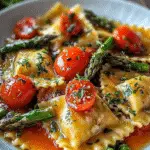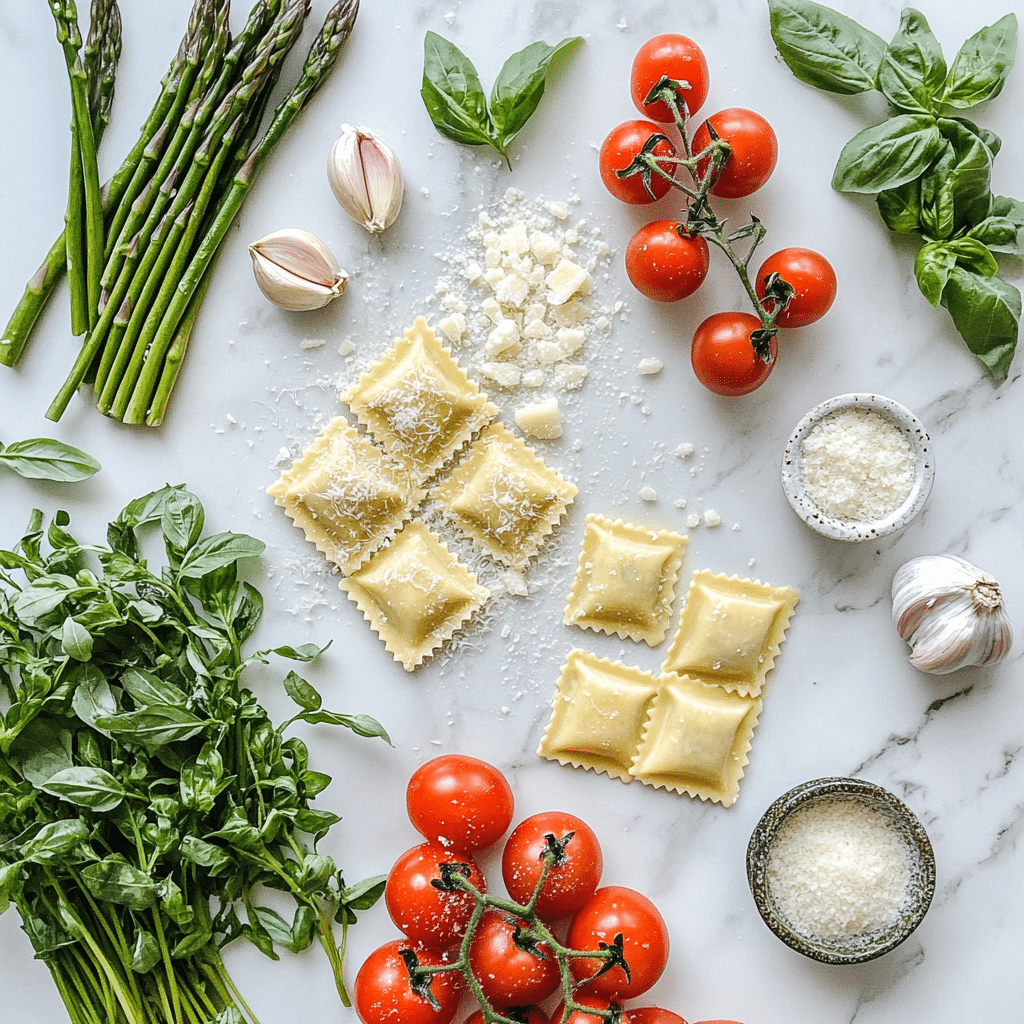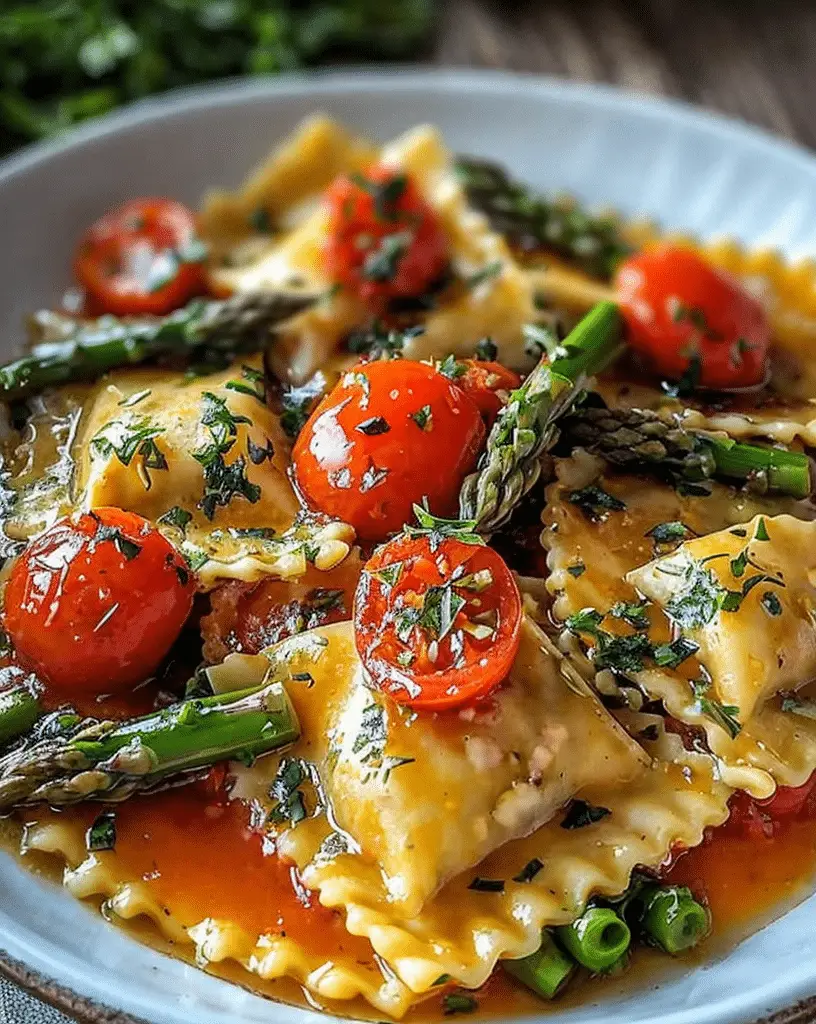Ravioli with Tomatoes, Asparagus, Garlic, and Herbs: A Luxurious Culinary Symphony
The irresistible flavor of homemade ravioli with tomatoes, asparagus, garlic, and herbs will transport you straight to the heart of Italian cuisine. This enticing dish, featuring deliciously tender ravioli tossed with bright tomatoes and crisp asparagus, is a feast for the senses. Infused with aromatic garlic and fragrant herbs, this recipe offers both a rich and refreshing palate experience. Perfect for weeknight dinners or a special weekend gathering, it masterfully balances the indulgence of pasta with the freshness of Mediterranean produce, making it a dish sure to impress.
Strong aroma and delightful textures come together to create an unforgettable dish for any occasion. As you prepare the ravioli with tomatoes, asparagus, garlic, and herbs, the kitchen fills with a rich medley of inviting scents. Tomatoes offer a burst of juicy sweetness, while asparagus adds a satisfying crunch. The well-rounded flavors come alive with each bite, thanks to the infusion of garlic and fresh herbs. Not only is the dish a feast for the tastebuds, but it also presents a beautiful tapestry of colors, from vibrant reds to lively greens.
Table of Contents
Quick Recipe Highlights
- Flavor Profile: The ravioli boasts a harmonious blend of savory and sweet, with hints of garlic cutting through the natural sweetness of fresh tomatoes, enhanced by the earthy tones of asparagus and a gentle herbaceous undertone.

Delicious Ravioli with Fresh Tomatoes, Asparagus, Garlic, and Herbs
- Total Time: 25 minutes
- Yield: 4 servings 1x
- Diet: Vegetarian
Description
Ravioli with fresh tomatoes, asparagus, garlic, and herbs is a vibrant, quick pasta dish that’s perfect for spring and summer. Light, bright, and packed with flavor, it’s the kind of meal that feels gourmet but is easy enough for weeknights.
Ingredients
1 lb cheese ravioli (fresh or refrigerated)
1 tbsp olive oil
2 cloves garlic, minced
1 pint cherry tomatoes, halved
1 bunch asparagus, trimmed and cut into 2-inch pieces
Salt and pepper, to taste
¼ tsp crushed red pepper flakes (optional)
2 tbsp fresh basil, chopped
1 tbsp fresh parsley, chopped
Grated Parmesan or Pecorino, for serving
Instructions
1. Bring a large pot of salted water to a boil and cook ravioli according to package instructions. Drain and set aside.
2. Meanwhile, heat olive oil in a large skillet over medium heat. Add garlic and sauté until fragrant, about 1 minute.
3. Add cherry tomatoes and cook until softened, about 3–4 minutes.
4. Stir in asparagus, season with salt, pepper, and red pepper flakes. Cook until asparagus is bright green and tender, about 4 minutes.
5. Add cooked ravioli to the skillet and toss gently to combine.
6. Stir in fresh basil and parsley. Taste and adjust seasoning as needed.
7. Serve warm with grated Parmesan or Pecorino on top.
Notes
Use fresh seasonal tomatoes and asparagus for the best flavor.
Swap in spinach or zucchini if asparagus is out of season.
To make it vegan, use dairy-free ravioli and skip the cheese.
- Prep Time: 10 minutes
- Cook Time: 15 minutes
- Category: Dinner, Pasta
- Method: Stovetop
- Cuisine: Italian
Nutrition
- Serving Size: 1 bowl
- Calories: 420
- Sugar: 5g
- Sodium: 560mg
- Fat: 14g
- Saturated Fat: 5g
- Unsaturated Fat: 8g
- Trans Fat: 0g
- Carbohydrates: 52g
- Fiber: 4g
- Protein: 16g
- Cholesterol: 45mg
Keywords: ravioli with fresh tomatoes, asparagus ravioli pasta, summer herb ravioli
- Texture: Enjoy the delightful contrast between the silky smoothness of ravioli and the satisfying crispness of asparagus. A touch of tomatoes adds juiciness, while fresh herbs contribute a subtle, leafy crunch.
- Aroma: The dish carries an enticing aromatic profile, highlighted by the robust scent of sautéed garlic and the mellow earthiness of cooked asparagus entwined with hints of fresh basil and parsley.
- Visual Appeal: The vibrant reds of tomatoes, bright greens of asparagus, and hints of white garlic infused pasta create a visually engaging plate that is both inviting and elegant.
- Skill Level Needed: Though requiring some finesse, the recipe is approachable for intermediate cooks. Making ravioli from scratch may challenge beginners, but pre-made options are available for ease.
- Special Equipment: A pasta roller for homemade ravioli is ideal, but store-bought options simplify the process. A sharp knife and a non-stick sauté pan help in executing the recipe effortlessly.
Recipe Overview
- Difficulty Level: Medium; balancing multiple ingredients and techniques requires some skill. It’s manageable with patience, ensuring a rewarding experience for those stepping up from straightforward dishes.
- Category: This is a versatile main course perfect for lunch or dinner, special enough for a celebration meal but approachable for a casual family gathering.
- Cuisine: Rooted in Italian culinary traditions, this dish brings Mediterranean flavors to the fore, celebrating classic ingredients like pasta, tomatoes, garlic, and fresh herbs.
- Cost: The recipe is relatively budget-friendly, with most ingredients being inexpensive, particularly if you use store-bought ravioli.
- Season: Best enjoyed in spring and summer, when tomatoes and asparagus are at their peak, although the dish can delight year-round with accessible produce.
- Occasion: Ideal for romantic dinners, family celebrations, or a charming alfresco dining experience, bringing an Italian flair to the table.
Why You’ll Love This Recipe
Taste and texture marry beautifully in this recipe, offering an indulgence without heaviness. The contrast of ravioli with tender vegetables is both satisfying and refreshing, delivering a comforting, yet light meal. The use of fresh herbs and high-quality ingredients ensures an authentic Italian taste that resonates with those seeking genuine culinary experiences.
Convenience is another noteworthy aspect, with a relatively short preparation and cooking time. Making ravioli from scratch can be a joyful endeavor, but using pre-made alternatives allows for a sumptuous meal even on busy evenings. Whether you have a bustling household or are looking to impress guests, this recipe offers flexibility and ease.
The nutritional value of this dish shouldn’t be overlooked. Asparagus is a great source of vitamins A, C, and K, while tomatoes provide an antioxidant boost with their rich lycopene content. This recipe offers a balanced meal, combining protein from ravioli and an array of vegetables, making it both a delicious and nourishing option.
Social gatherings are an ideal setting for this dish, which encourages camaraderie through shared enjoyment of good food. Serving this pasta at a dinner party or potluck will surely capture guests’ attention with its sophisticated flavors and delightful presentation.
Cost-effectiveness is balanced with quality and flavor. While ravioli and fresh vegetables might seem luxurious, these ingredients can be found at reasonable prices, especially when opting for in-season produce. A little effort goes a long way in creating a restaurant-quality dish at home without straining your budget.
Historical Background and Cultural Significance
Ravioli has its origins deeply intertwined with Italian culinary history, dating back to the Middle Ages. Originally used as a practical dish by resourceful Italian homemakers, ravioli served as a means to utilize excess ingredients by encasing them in pasta, ensuring nothing went to waste. Passed down through generations, it evolved into a beloved staple that showcases the ingenious creativity within Italian cuisine.
The cultural importance of ravioli cannot be overstated. Embraced as a symbol of family gatherings and celebrations in Italy, these delicate pasta parcels reflect the country’s rich culinary tapestry. Italians have long cherished ravioli as part of their varied regional traditions, demonstrating the adaptability and creativity inherent to Italian cooks.
While remaining fundamentally unchanged, the evolution of ravioli across disparate regions has allowed diverse interpretations to flourish. Northern Italy might include fillings with meat and cheeses, whereas southern regions prefer light and vegetable-based fillings. The versatility of ravioli has made it a culinary muse, inspiring cooks around the world to craft unique variations that honor both their heritage and Ravioli with Tomatoes personal creativity.
Regional variations abound, bringing subtle yet delightful differences to each table. In Venice, ravioli might be paired with a luxurious seafood sauce, while in Tuscany, one may find it cloaked in rustic tomato and basil-based dressings. These adaptations exemplify the adaptability of ravioli, making it a canvas for showcasing Italy’s varied geography and produce.
Ingredient Deep Dive
Tomatoes are fundamental to Italian cooking, known not only for their rich flavor but also cultural significance. With ancient origins in the Americas, tomatoes flourished in Europe post-Columbian Exchange. Their arrival significantly impacted Southern European cuisines, becoming emblematic of Mediterranean diets. In this recipe, tomatoes provide sweetness and umami, while offering health benefits like lycopene, essential for cardiovascular wellness.

Proper selection of tomatoes is crucial. Opt for plump, deep-hued fruit free from bruises. For juiciness, vine-ripened or heirloom varieties are ideal. Store on countertops to enhance flavor, avoiding refrigeration which can dull taste. Should fresh tomatoes prove elusive, quality canned forms an adequate substitute.
Asparagus, another key ingredient, traces its cultural roots to Ancient Rome, celebrated for both culinary and medicinal properties. Prized for its delicate flavor, asparagus signifies the arrival of spring, often featured prominently in Italian primavera dishes, adding a crisp, verdant element to the meal.
Nutritionally, asparagus provides an array of health benefits, being rich in fiber and antioxidants. Select firm, bright spears with closed tips, and store bundled in a damp cloth within the refrigerator to extend freshness. When substitutions are necessary, green beans may replace asparagus, offering a similar textural experience.
Common Mistakes to Avoid
1. Overcooking ravioli: Cook in a gentle boil for optimal doneness, checking frequently.
2. Undercooked asparagus: Ensure it’s tender yet crisp, blanching helps.
3. Tomato choice: Use ripe, flavorful varieties to avoid blandness.
4. Too much garlic: Balance carefully to avoid overpowering other flavors.
5. Skimping on herbs: Freshness is key for aromatic impact.
6. Improper seasoning: Taste and adjust throughout to achieve balanced flavors.
7. Keeping vegetables too long: Serve immediately to retain vibrancy.
8. Forgetting to reserve pasta water: Act as a binding agent for the sauce.
Essential Techniques
Mastering the balance of cooking time is key for perfect ravioli. Overcooked pasta results in mushy mouthfeel, whereas undercooked can be chewy. Achieving al dente requires attention to detail, checking periodically, and aided by the test-bite method.
Sautéing garlic is another essential technique, releasing aromatics that heighten overall flavor profile. Avoid browning or burning, as this imparts bitterness. Gentle heat is optimal, with keen observation necessary for success.
Pro Tips for Perfect Ravioli with Tomatoes, Asparagus, Garlic, and Herbs
1. Use high-quality olive oil for richer flavor; it elevates the sauce beautifully.
2. Add a splash of white wine for a touch of acidity, enhancing depth.
3. Consider lemon zest for freshness, lifting the entire dish.
4. Be flexible with herbs; a blend of basil and parsley provides a harmonious result.
5. If possible, allow ravioli mixture to rest before final assembly, intensifying taste.
6. Experiment with cheese garnishes, such as finely grated Parmesan for umami richness.
Variations and Adaptations
Regional variations can add intrigue to ravioli dishes, such as incorporating truffles for a distinctive touch or seafood for coastal flair. As seasons change, so too can ingredients. Swap asparagus for winter squash, maintaining balance with sweet and earthy tones.
For dietary requirements, gluten-free pasta options are available, ensuring everyone enjoys the meal without compromise. Vegans may substitute dairy-free alternatives or embrace vegetable fillings exclusively. These adaptations illustrate the profound flexibility afforded by this dish.
Serving and Presentation Guide
Serve ravioli on warmed plates, artfully arranging for enticing presentation. Add basil chiffonade as garnish, imparting visual flair and extra fragrance. Traditional accompaniments may include crusty bread, perfect for soaking up sauce remnants. Such thoughtful touches enhance dining experience.
Wine and Beverage Pairing
A crisp white wine, such as Pinot Grigio, harmonizes beautifully with the bright flavors, while a red Chianti offers a bolder contrast. Non-alcoholic alternatives might include sparkling water enhanced with citrus, providing zest and refreshment in equal measure. Choose a beverage that complements rather than masks the dish’s vibrant flavors.
Storage and Shelf Life
For freshness, consume within 24 hours, but leftovers can store in airtight containers under refrigeration for up to three days. Signs of spoilage include off-odors or slime, mandating disposal. For reheating, gently warm in a non-stick skillet to preserve texture and flavor.
Make Ahead Strategies
Preparation can be staggered, with pasta dough made in advance, refrigerated for up to 48 hours. Asparagus may be blanched ahead, retaining vibrant color and crunch. Strategies such as these aid in serving a freshly prepared meal with minimal day-of effort, ensuring optimal results.
Scaling Instructions
This recipe scales effectively for large gatherings with modest adjustments. Doubling ingredients is straightforward, but check seasoning levels frequently. If halving, maintain attention to timing, as smaller batches cook rapidly. Storage considerations remain the same, ensuring each portion retains quality.
Nutritional Deep Dive
This dish is relatively balanced, providing moderate carbohydrates, protein, and valuable fiber from vegetables. Tomatoes contribute vitamin C and lycopene, while asparagus offers magnesium and folate. Conscious portion control, mindful of pasta quantities, aids those with dietary goals without denying indulgence.
Dietary Adaptations
For gluten-free adaptations, utilize rice-based or alternative flour pasta, avoiding cross-contamination. Dairy-free options arise by substituting cheese alternatives in fillings. Vegan variations omit animal products entirely, while still offering robust flavor through careful selection of vegetables and seasonings.
Troubleshooting Guide
Texture issues often stem from overcooking or undercooking pasta. Refining timing through practice resolves these. Adjust flavor balance by incorporating acid or sweetness, while equipment challenges, such as dough consistency, call for gradual flour incorporation, balancing hydration. Ingredient substitutions ensure accessibility without sacrificing quality.
Recipe Success Stories
Readers often share tales of adaptation and success, such as integrating local ingredients or opting for seasonal produce. Photographic tips arise from thoughtful presentation choices, elevating the dish’s appeal across digital platforms, aligning visual appeal with sensory satisfaction.
Can I use frozen ravioli?
Yes, just cook according to the package and be sure not to overboil to keep the shape intact.
What other vegetables can I substitute?
Zucchini, spinach, or green beans are excellent alternatives to asparagus.
Is this dish good for meal prep?
Yes, it reheats well. Store in an airtight container and reheat gently with a splash of olive oil.
Can I use dry herbs instead of fresh?
Fresh is best, but if using dried, reduce the amount by half.
Additional Resources
Explore related recipes, such as risottos or pasta sauces, extending Italian culinary offerings. Technique guides for pasta-making and sautéing enhance foundational skills. Delve further into ingredient profiles, gaining deeper appreciation for common culinary elements. Seasonal variations inspire continued exploration of delightful Italian cuisine.Creamy Garlic Mushroom Ravioli .
Conclusion
Ravioli with fresh tomatoes, asparagus, garlic, and herbs is a fresh, fast, and flavorful dish that celebrates the beauty of seasonal ingredients. The tomatoes burst with juiciness, the asparagus adds crisp-tender texture, and the herbs tie it all together with garden-fresh charm.
Whether you’re preparing a quick weeknight dinner or a light summer meal for friends, this pasta recipe is a winner. Once you try Ravioli with Fresh Tomatoes, Asparagus, Garlic, and Herbs, you’ll keep it in your warm-weather rotation.




